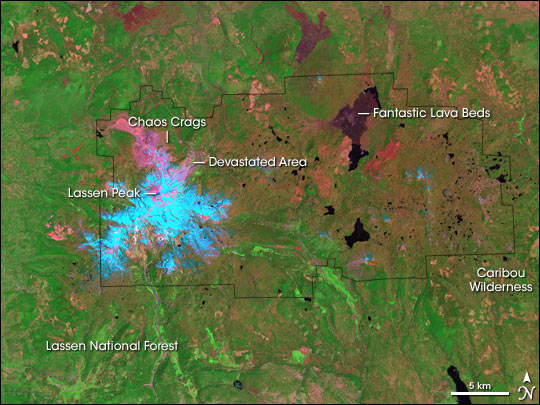
Lassen Volcanic National Park
Downloads
- lassen_l7_2000175_lrg.jpg (4000x4000, JPEG)
Metadata
- Sensor(s):
- Data Date:
- Visualization Date: January 29, 2006
Lassen Volcanic National Park lies in Northern California at the southern end of the Cascade Range. Along the western edge of the park is Lassen Peak, the active volcano for which the park was named. Although nearly a century has passed since its last eruption, signs of volcanic activity are still visible in this Landsat 7 false-color image. At 3,187 meters (10,456 feet), the peak is covered with snow, even though the image was taken in late June. The snow is blue in the false-color image. To the northeast of Lassen Peak is the Devastated Area. A 1915 eruption sent a flow of hot mud, water, and rocks (a lahar) barreling northeast across the Devastated Area. The eruption killed the forest and left a trail of loose rocks. Though the forest is returning, the rocks in the flow give the Devastated Area its pink color. To the northwest of Lassen Peak are the Chaos Crags, a series of dome volcanoes. Again, the non-vegetated rock is pink. An arc of snow-covered peaks extends southwest from Lassen Peak. These peaks are the remnants of Mt. Tehama, the massive ancient volcano from which Lassen Peak was born.
Another volcanic feature, not directly related to Lassen Peak, is in the northeast corner of the park. The Fantastic Lava Beds are basalt lava flows that came from Cinder Cone, a cinder cone volcano on the western edge of the flows. The flows dammed creeks, creating Snag Lake, the large lake to the south of the Fantastic Lava Beds, and Butte Lake to the north. The lakes appear black in contrast to the lava flows.
Lassen Peak is the southernmost in the chain of 13 large volcanic peaks that run from Washington to California. The peaks formed in the past 35 million years as the Juan De Fuca plate and the tiny Gorda plate to its south have been pulled under the overriding North American plate. As the oceanic crust in the Juan de Fuca plate melts under the pressure, it creates pools of lava that drive up the Cascade Range and power periodic eruptions in its volcanic peaks. The most recent volcanic eruption was at Mount St. Helens, but in 1914, Lassen began a seven-year-long series of eruptions. The most powerful of these eruptions was a 1915 episode that sent ash and steam in a ten-kilometer-tall mushroom cloud, making it the largest recent eruption in the contiguous 48 states until Mt. St. Helens took that title in 1980. The region remains geologically active, with mud pots, active fumaroles, and boiling water features, several of which are getting hotter. Lassen Volcanic National Park and nearby Shasta Peak are considered the most likely volcanoes in the Cascade Range to shift from dormancy to active eruptions.
These data were collected by Landsat 7’s Enhanced Thematic Mapper Plus (ETM+) instrument on June 23, 2000. The image was created by combining data from the sensor’s shortwave-infrared, near-infrared, and green channels (ETM+ bands 7, 4, and 2 respectively).
NASA image created by Jesse Allen, Earth Observatory, using data obtained from the University of Maryland’s Global Land Cover Facility.
This image record originally appeared on the Earth Observatory. Click here to view the full, original record.